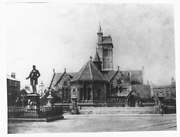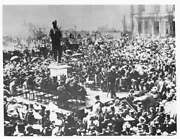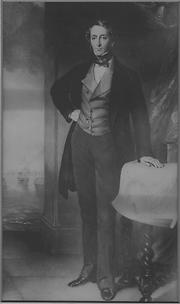 Hartlepool Sports & Leisure
Hartlepool Sports & Leisure
- Cinemas, Theatres & Dance Halls
- Musicians & Bands
- At the Seaside
- Parks & Gardens
- Caravans & Camping
- Sport
 Hartlepool Transport
Hartlepool Transport
- Airfields & Aircraft
- Railways
- Buses & Commercial Vehicles
- Cars & Motorbikes
- The Ferry
- Horse drawn vehicles
 A Potted History Of Hartlepool
A Potted History Of Hartlepool
- Unidentified images
- Sources of information
- Archaeology & Ancient History
- Local Government
- Printed Notices & Papers
- Aerial Photographs
- Events, Visitors & VIPs
 Hartlepool Trade & Industry
Hartlepool Trade & Industry
- Trade Fairs
- Local businesses
- Iron & Steel
- Shops & Shopping
- Fishing industry
- Farming & Rural Landscape
- Pubs, Clubs & Hotels
 Hartlepool Health & Education
Hartlepool Health & Education
- Schools & Colleges
- Hospitals & Workhouses
- Public Health & Utilities
- Ambulance Service
- Police Services
- Fire Services
 Hartlepool People
Hartlepool People
 Hartlepool Places
Hartlepool Places
 Hartlepool at War
Hartlepool at War
 Hartlepool Ships & Shipping
Hartlepool Ships & Shipping

Jackson, Ralph Ward
Ralph Ward Jackson has gone down in history as the man who built West Hartlepool.
He saw potential in an area which was at the time only villages and sand dunes. He brought trade and industry to West Hartlepool. He helped to plan the layout of town, and was responsible for the first public buildings. He was also involved in the education and the welfare of the inhabitants.
Ralph Ward Jackson was born on 7th June 1806, the third son of William Ward Jackson, of Normanby Hall, Eston, Yorkshire. His family were wealthy, and could trace their ancestry back to the beginning of the 17th century. Ralph was educated at Rugby School, Warwickshire.
Ralph Ward Jackson was married to Susannah, daughter of Charles Swainson of Lancashire, in 1829. They had one surviving son, William, born c1833. Their other children died in infancy. The family lived at Greatham Hall, in Greatham Village on the outskirts of West Hartlepool. Susannah Ward Jackson died in October 1865.
Ralph Ward Jackson left school at the age of sixteen to begin a career as a solicitor. He trained in Preston, Lancashire. After he qualified, in 1829, he went into partnership with Joseph Frank. Frank was an established solicitor in Stockton-on-Tees, about 10 miles from Hartlepool. Ward Jackson became a legal advisor for the Clarence Railway Company, and later for the Stockton and West Hartlepool Railway. After Frank’s death Ward Jackson took sole control of the firm, but he was no longer interested in practising law. He gave up the firm in 1854, to concentrate on developing the railway and docks at West Hartlepool.
In the 1830s railway lines were being built across the north east of England. These were needed to carry coal from the local collieries to the south, to provide fuel for the new machinery of the Industrial Revolution. Local businessmen realised that money could be made from these new trade links. In 1838 Ward Jackson joined a group of businessmen to set up the Stockton and Durham County Bank, in the hope that they could take advantage of the new prosperity. As it turned out, the bank was not a success, and after eight years business was transferred to the National and Provincial Bank.
Ward Jackson also became involved in the railways in a more direct way. The Clarence Coal Railway had recently been built between the Durham coalfields and Stockton, on the River Tees. It was not, however, proving profitable. Once the coal was unloaded from the train, it had to be taken by ship down the river to the sea. The Tees was a difficult river to navigate, full of bends and sandbanks. Ships had to be pulled part of the way by horses. In 1839 it was decided to build a new eight-mile stretch of railway called the Stockton and Hartlepool Railway. It would join the existing railway with Hartlepool. Here, ships had direct access to the sea, without needing to navigate any rivers. Ralph Ward Jackson became a shareholder in the company responsible for building the new line. Ward Jackson was made the Managing Director of this new railway in 1848.
When the Stockton and Hartlepool Railway opened in 1841 it brought coal to the docks at Old Hartlepool, to be taken away by ships. The Hartlepool Dock and Railway Company ran the dock. They charged a high fee to rival companies who wanted to use their facilities. In 1844 Ward Jackson went to Parliament for permission to build his own harbour and dock at West Hartlepool. In spite of opposition from supporters of the Dock and Railway Company this was granted, and building started in spring 1845. The company running the new docks was the West Hartlepool Harbour and Dock Co., and Ward Jackson was made Managing Director of it in 1846. The first West Hartlepool dock, known as the Coal Dock, was opened on 1st June 1847. The second, called Jackson Dock, followed on 1stJune 1852. A year later, in 1853, Ward Jackson’s railway company (the Stockton and Hartlepool Railway) and his dock company (the West Hartlepool Harbour and Dock Co.) were joined together to form the West Hartlepool Harbour and Railway Company. A third dock opened on 3rd June 1856, and was called Swainson Dock.
Ward Jackson was keen to see the new town of West Hartlepool develop. At the end of the 1830s the area had been made up of a few small villages and a lot of marshes and sand dunes. The arrival of the railway, and the shipping of coal from the new dock in the 1840s, had brought money and people into the area. A town began to grow up around the harbour, and Ward Jackson was the person who did most to encourage it.
The West Hartlepool Harbour and Dock Co. (of which Ward Jackson was the managing director), owned large areas of land around the new harbour. They laid out the first streets, and provided a sewerage system. The stone which had been cut away to make the docks was magnesian limestone, which was a good building material. The dock company donated the stone and the land to build public buildings such as Christ Church. This still stands today, and now houses the town’s art gallery.
Ward Jackson was also responsible for the first shipbuilding yard in West Hartlepool. He included facilities for shipbuilding in the design of Jackson Dock. He then invited John Pile, a successful shipbuilder from Sunderland, twenty miles north of Hartlepool, to relocate his business.
As the population grew, better facilities such as street lighting and a cemetery were needed. Ward Jackson applied to Parliament for an Improvement Act. This would recognise West Hartlepool’s status as a town, and allow a proper means of local government to be formed. The Act was granted in June 1854. In September of the same year, the first meeting of the Board of Improvement Commissioners was held. These were the people who would organise how the town was run. Ralph Ward Jackson was appointed as their chairman, and remained in this post until his retirement in 1870.
Ralph Ward Jackson had a huge influence on the growth on West Hartlepool. He did all he could to promote the town, and bring trade and money into it. Within twenty years the port became one of the busiest on the north east coast. As head of the West Hartlepool Harbour and Railway Company, Ward Jackson invested money into collieries in County Durham. He also bought a fleet of steamships to export the coal. Unfortunately, this was not allowed under the terms which governed the running of the Harbour and Railway Company. This was pointed out by Benjamin Coleman, a shareholder in the company, in 1861. Coleman ran a campaign which resulted in the resignation of Ward Jackson from the Board of Directors.
In spite of his resignation over irregular dealings in the Harbour and Railway Company, Ward Jackson remained popular with local people. It was felt that everything he had done had benefited the town, even if his methods had not been strictly legal. In 1868 he was elected as the Hartlepools first Member of Parliament. He held the seat, as a Conservative, for six years. He was defeated by local businessman Thomas Richardson in the General Election of 1874.
Ward Jackson was forced to resign from the West Hartlepool Harbour and Railway Company in 1862. This was after an investigation which showed that he had carried out business dealings which were not allowed under the terms which governed the running of the company. The business was taken over by the North-Eastern Railway Company (NER). Legal arguments between Ward Jackson and NER went on until 1872. Although Ward Jackson won the case, he lost most of his money in the process. His later years were spent in near-poverty. At the time of his death, some of his friends were attempting to raise money to support him.
Ward Jackson died in London on 6th August 1880. He was 75. He was buried in London, but on the day of his funeral the people of West Hartlepool showed their respect. In the harbour ships flew their flags at half-mast. Shops were closed, and the bells of Christ Church were rung.
Ralph Ward Jackson led a stormy life. He was several times involved in legal battles with people who opposed him. In 1861 he was fined for assaulting the vicar of Greatham after an argument over public rights of way. But he was also a man of great vision and purpose. He was passionate about everything to do with West Hartlepool, and was involved in almost every part of the town’s early growth.
The docks he built have now been made into a marina. The railway still follows the same route through the town. Ward Jackson Park was opened in 1883, and has recently been renovated. It was originally paid for from money which had been raised by wellwishers. This was to support Ward Jackson after the lengthy legal battle with NER, which left him almost bankrupt. After his death it was decided to use the money for a public park, as a lasting memorial. A statue of Ward Jackson was unveiled in 1897. It stands at the top of Church Street, one of the first streets to be laid out in West Hartlepool. It faces down the street, looking towards the railway line and the sea, around which the town grew. However, a song performed in a local theatre a few years before his death expresses the feelings of the townspeople at the time:
“…No need for pillar raised to him in brass or stone, His monument’s a Town, it stands alone!”
Related items :
 Christ Church 1903
Christ Church 1903
 Donated by Douglas Ferriday
Donated by Douglas FerridayPart of the Hartlepool Library Service collection
Christ Church with the Ralph Ward Jacson statue.
More detail » Opening of Ralph Ward Jackson Statue
Opening of Ralph Ward Jackson Statue
 Donated by Douglas Ferriday
Donated by Douglas FerridayPart of the Hartlepool Library Service collection
 Ralph Ward Jackson
Ralph Ward Jackson
 Created by Frances Gent
Donated by Hartlepool Museum Service
Created by Frances Gent
Donated by Hartlepool Museum ServiceCopy of Frances Gent's portrait.
More detail » Ralph Ward Jackson Statue
Ralph Ward Jackson Statue
 Donated by Hartlepool Museum Service
Donated by Hartlepool Museum ServicePart of the Photo Box 6 collection
The statue of Sir Ralph Ward Jackson being lowered onto it's pedestal in Church Street in the 1950's. Christ Church can be seen in the background.
More detail » Ralph Ward Jackson Statue
Ralph Ward Jackson Statue
 Donated by Hartlepool Museum Service
Donated by Hartlepool Museum ServiceRalph Ward Jackson, founder of West Hartlepool & the driving force behind the erection of Christ Church which is in the background.
More detail » Ward Jackson
Ward Jackson
As well as being known as the founder of West Hartlepool, Ralph Ward Jackson had many business and property interests. He had shares in several sailing vessels both with individuals and companies. He was involved with the West Hartlepool Shipping Company formed in 1849 and when that ceased trading he transferred his interests in 1854 to the West Hartlepool Harbour and Railway Company and bought a small fleet of ships. This Company was the forerunner to the WHSNC which was formed in 1856. Between 1867 and 1870 he co-owned vessels with the North Eastern Railway Company.
More detail »



